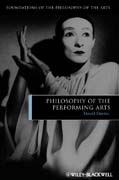
This book provides an accessible yet sophisticated introduction to the significant philosophical issues concerning the performing arts. Presents the significant philosophical issues concerning the performing arts in an accessible style, assuming no prior knowledge Provides a critical overview and a comprehensive framework for thinking about the performing arts Examines the assumption that classical music provides the best model for thinking about artistic performance across the performing arts Explores ways in which the classical paradigm might be extended to other musical genres, to theatre, and to dance Applies the thinking on performing arts to the issue of performance art INDICE: Part I: Performance and the Classical Paradigm. Chapter 1 The Nature of Artistic Performance. I Introduction. II What is a performance? III Institutional theories of artistic performance. IV Aesthetic theories of artistic performance. V Artistic performance and artistic regard. VI Overview. Chapter 2 The Classical Paradigm I: The Nature of the Performable Work. I Introduction: Berthold and Magda go to the symphony. II The multiple nature of performableworks. III Performable works as types. IV Varieties of type theories: sonicism, instrumentalism, and contextualism. V Other theories of the performable work. a/ Performable works as indicated types. b/ Performable works as continuants. c/ Performable works as indicatings of types. d/ Fictionalism about performable works. Chapter 3 The Classical Paradigm II: Appreciating Performable Works in Performance. I Introduction: talking appreciatively about performable works. II Can performable works share artistic properties with their performances? III The Goodman argument. IV Answering the Goodman argument. Chapter 4 Authenticity in Musical Performance. I Introduction. II Authenticity in the arts. III Three notions of historically authentic performance. a/ Authenticity defined in terms of composers intentions. b/ Authenticity defined in terms of the sound of the work. c/ Authenticity defined in terms of performance practice. Chapter 5 Challenges to the Classical Paradigm in Music. I Introduction: The classical paradigm in the performing arts. II The scope of the paradigm in classical music. III Jazz, rock, and the classical paradigm. a/ Jazz. b/ Rock. IV Non-Western music and the classical paradigm. Chapter 6 The Scope of the Classical Paradigm: Theatre, Dance, and Literature. I Introduction: Berthold and Magdago to the theatre. II Theatrical performances and performable works. III Challenges to the classical paradigm in theatre. IV Dance and the classical paradigm. V The novel as performable work? Part II: Performance as Art. Chapter 7 Performances as Artworks. I Introduction: spontaneous performance in the arts. II The artistic status of performances outside the classical paradigm. III The artistic status of performances within the classical paradigm. Chapter 8 Elements of Performance I: Improvisation and Rehearsal. I Introduction. II The nature of improvisation. III Improvisation and performable works: three models. a/Improvisation on a theme. b/ Improvisational composition. c/ Pure improvisation. IV Improvisation and recording. V The place of rehearsal in the performingarts. Chapter 9 Elements of Performance II: Audience and Embodiment. I Can there be artistic performance without an audience? II Audience response. III Theembodied performer and the mirroring receiver. Chapter 10 Performance Art andthe Performing Arts. I Introduction. II Some puzzling cases. III What is
- ISBN: 978-1-4051-8802-9
- Editorial: Wiley-Blackwell
- Encuadernacion: Cartoné
- Páginas: 248
- Fecha Publicación: 08/04/2011
- Nº Volúmenes: 1
- Idioma: Inglés
